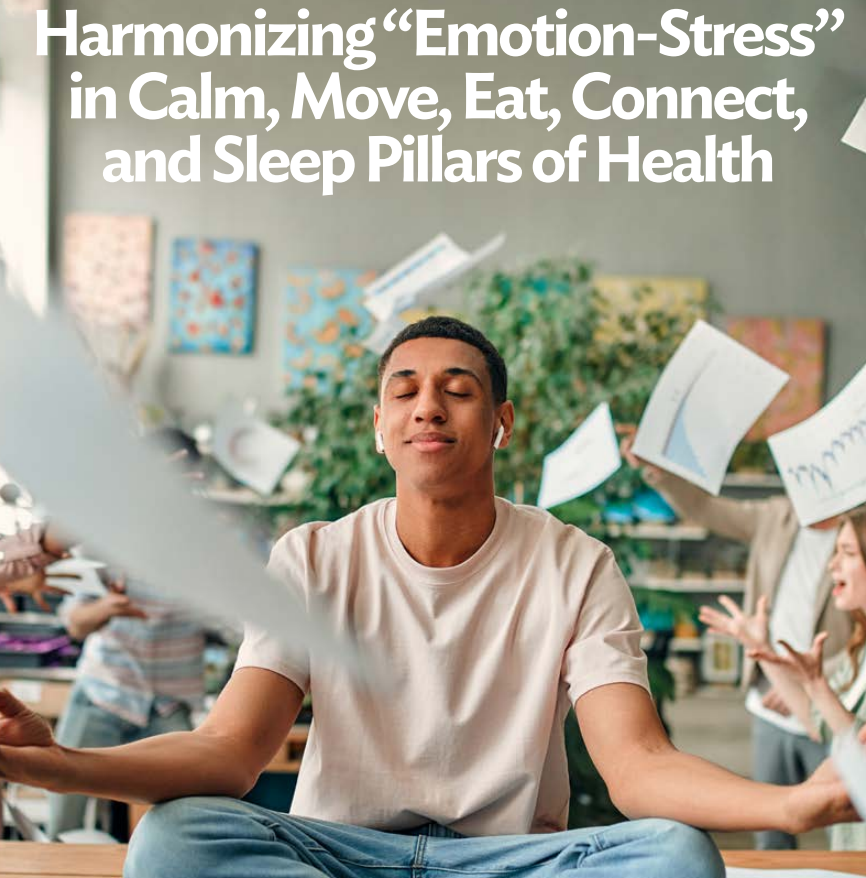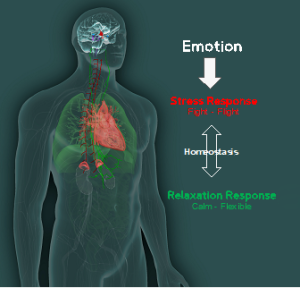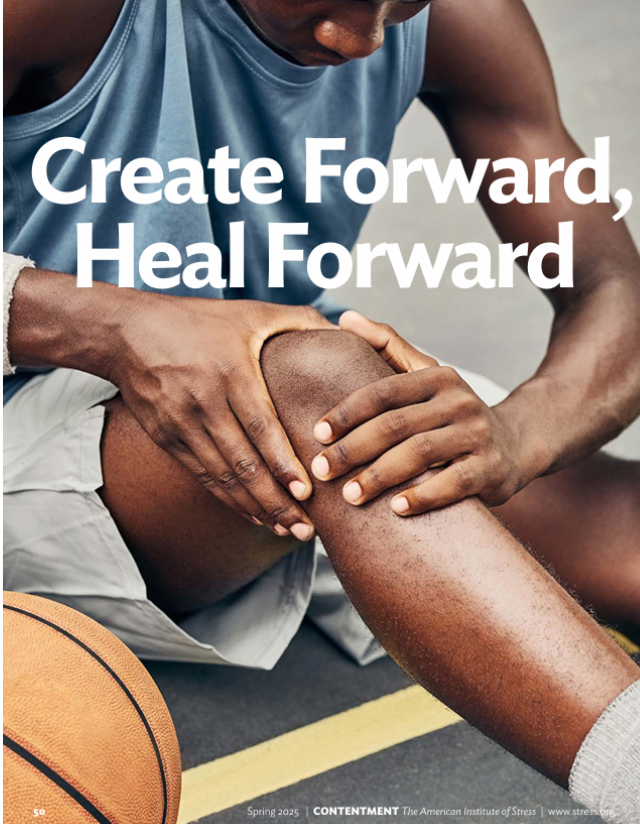
*This is an article from the Winter 2023-24 issue of Contentment Magazine.
By Evian Gordon, MD, PhD, FAIS and Donna Palmer, PhD
The Emotion-Stress Continuum: from Attitude to In-the-Moment to a Lifestyle Habit.
At your brain’s “safety first” core, emotion neural networks automatically, rapidly (in a fifth of a second), and continually identify environmental and body language cues to help ensure that you avoid threats and identify possible rewards.1
Emotions also drive your stress feelings. Emotions and feelings are different but complementary. Feelings are your body’s physical responses to emotions. Emotions are the cause. Feelings are the effect.
Feelings such as stress create a conscious awareness in your body through changes in heart rate, sweating, breathing, and “gut” activation.
At a brain-behavior level, stress occurs when negative demands exceed your capacity to consciously cope effectively. The gap between demand and capacity can be acute in the moment or can become chronic over time. There is an acute-chronic continuum. It is very well established that chronic stress is toxic to your body’s health, mental health, and performance. The “Stress Response” to any actual or perceived threat induces a fight-flight response. Some stress is helpful, such as getting you out of immediate danger or helping you focus on completing a task. But when stress is overwhelmingly negative or continually triggered and becomes chronic, it derails performance and increases the likelihood of mental disorders and chronic disease.
It is now evident that the sooner stress is stopped “in the moment,” the more effectively you will control the overall cascade of stress effects. A positive attitude and calm mindset set the foundation tone and priming for any stress state and your likelihood of being present in the moment and rewiring a calm state into a habit.
These processes underpin your core brain-body homeostasis, which Dr. Lewis Coleman has proposed as the mechanism underlying the Stress Response. He highlights the importance of stopping any “overreaction” to stress.2 Stress over-reaction disruption of homeostasis results in a cascade of toxic negative impacts that “produces a bewildering blizzard of destructive disease effects that disrupt physiology and damage organs and tissues.”3
At the opposite end of the spectrum to the stress response is the “Relaxation Response,” which induces a calm, more flexible brain and associated body state. The Relaxation Response helps you cope effectively with your life’s demands.
Daily life is an ongoing fluctuation and balance between your stress and relaxation responses.
Your effectiveness at managing stress is increased by understanding what emotion triggers your stress and how effectively you put a brake on your stress response and boost your relaxation response.

Figure 1. Emotional threats to our safety trigger the fight-flight stress response within a fifth of a second. An array of proven techniques will help Personalize what works for you to activate your relaxation response.
This central Emotion-Stress dynamic shapes many of the approximately 50,000 thoughts you have daily. It is also the basis of your intuition, biases, mental health, well-being, and peak performance.
A range of techniques (summarized in Figure 3) have been shown to stop the activation of the stress response and activate the relaxation response Attitude – In the moment – Habit continuum.
The Stress Impact on Calm, Move, Eat, Connect, and Sleep Pillars of Health
All five main pillars of health – Calm, Move, Eat, Connect, and Sleep, are impacted by long-term stress and also themselves can either help or exacerbate problems with stress coping.
Taking a holistic brain-body system approach to the five pillars of health and their relationship to stress is the most effective way to establish a successful Stress Coping Strategy. This isn’t just about managing stress, but the extended brain-body impacts of toxic stress. Figure 2 demonstrates the objective and explicit relationship between stress and the five pillars of health using data from the first standardized International Brain Database that we set up four decades ago.
Calm. An example of a brain-based stress intervention is Resonant Breathing (around 6 breaths a minute – breathing in for 4 seconds and out for 6 seconds), which puts a brake on the fight-flight stress response and induces a brain-body calm state. Each technique to activate the reward system listed in Figure 3 activates calm brain networks and benefits every pillar of health.
Move. Exercise is known to impact the mental resources you have available to help cope with stress. Exercise creates new neural connections in the brain via neurogenesis and neuroplasticity and releases endorphins, which boost activity in the happiness and reward-related emotion brain networks. Any amount of exercise is beneficial for improving stress, with regular daily exercise being the most effective pattern for improving stress and sleep quality (with better sleep quality also having a flow-on effect of improving stress coping.4 Even taking a short daily walk during lunch can significantly impact mood and help reduce work-related stress.5
Eat. Being in a state of high stress leads to poorer eating habits. Higher stress makes it harder to think clearly or focus, reduces patience tolerance levels and the ability to plan ahead and follow through on that plan. In an additive effect to this, the heightened negative emotion brain state associated with stress leads us to seek out “rewards” in our food choices, and together, these influences lead to selecting poorer food choices in times of stress. The influence between stress and food also goes back the other way, with poor diet choices such as high sugar content and fast foods leading to poorer mental resources for stress coping. Sugar creates a spike in blood sugar levels, which, as they then rapidly fall, makes you irritable and stress intolerant on the way back down. Inflammation can also occur due to poor food choices, causing stress and worsening existing stress. Mindful food choices, a calm brain state, and slow eating with presence and gratitude are powerful antidotes to mitigate the unintended consequences of sugar, oil, salt (SOS) addictive eating.
Connect. Social connection and social bonding directly impact stress, as socially connecting with others releases oxytocin, decreasing the stress hormone cortisol. Being socially connected and having a social support network can play an important role in coping with stress. Having a social support network that is substantially smaller or poorer quality than what you would like to have is associated with higher stress and a poorer ability to cope with that stress level. Conversely, being highly satisfied with the social connections and support around you promotes better stress coping. Exercise also has a synergistic effect on socialization, with any amount of regular walking or other physical activity being associated with higher energy and socialization with others.
Sleep. Sleep and stress have a bidirectional relationship. High levels of stress lead to ongoing heightened brain vigilance and thus, difficulty getting to sleep. This is an effective mechanism to keep us safe when a real physical threat is close by but does not help us cope with the types of stress that exist in modern life. Poor sleep leads to much poorer stress coping mechanisms due to reduced emotional tolerance, increased irritability, and poorer cognitive capacities for focusing and planning. This bidirectional relationship can easily lead to a spiraling of increasing stress, poorer emotional coping, and ongoing poor sleep. One way to break this cycle is to practice resonant breathing, listen to brain entrainment music, use Alpha-Stim cranial electrotherapy stimulation technology, and do a body scan relaxation before bed. Find what works for you to reduce pre-sleep stress and induce an optimal onset of sleep and better sleep quality throughout the night.


Figure 2. Heightened stress impacts, and is impacted by, the five pillars of health. Calm: Resonant breathing practice increases calm and reduces stress in a dose-response manner (more training – calmer). Move, Eat, Connect, Sleep: lack of exercise, poor food choices, lower quality of social connectedness, and lack of sleep significantly increase stress. Data from a variety of studies from the first Standardized International Brain Database.
Figure 2 shows evidence-based data examples of the relationship between Stress and the 5 pillars of health. This research and data are being expanded in collaboration with the American Heart Association’s (AHA) online ThinkHeart! Program (www.thinkheart.totalbrain.com) to achieve peak brain-body healthy habits. The research will also systematically integrate stress measures, inflammation, genetics, gene expression, and the full spectrum of continuous biometrics, including HR/HRV, EEGs, and arousal in stress and all the pillars of health.
3 Ways to Reduce Emotion-Stress and Induce Calm in Your Life.
The five pillars of health and how they interact with stress are relevant to how you think about using the three key stress reduction techniques below. Even though each has merits, each has implications for impacting all the other pillars of health.
- Repetition.
Repetition of ANY Stimulus. Dr. Herbert Benson discovered something groundbreaking that can be applied to every pillar of health. Put: “any repetition technique will break the train of everyday thought.” For example, a repetition of slow breaths, saying a meaningful word or positive affirmation, repeating musical sounds or repeating yoga or tai chi movements, or chanting in meditation all will generate a calming relaxation response.3,6
- Presence.
Induce presence by focusing on your breath and senses. Use your surroundings to bring your awareness to this moment. What do you see, what do you hear? Ask yourself a simple question, “Am I fully present?”
Your brain can primarily focus on one thought at a time. Switching your focus to your physical surroundings can induce calm in your body. You can practice being present during a range of daily routines – while you are walking in nature or along the street, making coffee, or just sitting at your desk. Pay heightened attention to all sounds you can hear around you for a short time. Welcome all sounds without judgement and be open to exploring them with a child’s curiosity. You can do the same thing with what you can feel or what you can smell. This simple practice induces your calm-in-the-moment response and lets your brain stop being caught up in the typical flow of overwhelming thoughts, worries, and to-do lists. Focusing on your senses is a quick and simple way to become present in all of the pillars of health.
Mindfulness meditation is also effective for switching your brain to focus on the present moment. Mindfulness meditation has been directly shown to decrease activity in the amygdala, a key brain structure involved in heightened vigilance and alertness to potential danger.7
Cognitive Behavior Therapy (CBT) techniques can also be used to take control of persistent negative or worrying thoughts that distract from other tasks that you need to focus on. One such technique is to take one minute to sit with the distracting thought. You can acknowledge that it might be an important issue causing problems in your life, but also then decide to put it to one side for right this moment (and visualize doing so if you want to, so that the thought sits beside you instead of between you and the task you are completing), and decide that you are choosing to put it to one side for now and to focus on the task at hand in this moment instead. It is still important to think or talk through these thoughts and deal with them at an appropriate time, but this technique can be used for you to take back control of when you address these thoughts and not be hijacked in the moment by a negative worry spiral in a way that you have no control over. In this way, you can have a Strategy for what you will do the next time a worrying thought occurs to you.
- Positivity.
Visualization and Positive Affirmations “nudge” your brain into a calmer and more positive state of being by visualizing a symbol or scene with high emotional meaning. You can also repeat a word that inspires and motivates you into a positive state or purposely seek out and pay attention to even small positive things in your day. For example, something your child or partner says to you, someone bringing you coffee or an element of nature or an animal that you pass by. Because your brain’s stress and relaxation responses are triggered in a second, by purposely noticing positive things, even for a moment, you are consciously nudging your core brain networks responsible for calmness and positivity to become more active. Having a more active calm-brain network also means that future stress events will likely trigger a smaller stress response and lead to quicker stress recovery. This will also train your brain to start noticing other positive things and paying attention to them, rather than only noticing the stressful or threatening things and ignoring all the positive nudges you encounter.
Working these techniques into your daily routine is key. Just 5-10 minutes per day as a regular practice quickly becomes a daily built-in stress-coping practice. Try out different types of the options described in Figure 3, and then continue with and MAGNIFY the ones that work best for you and, most importantly, that you want to and will continue to include as a daily practice.

Figure 3. List of established techniques to have a positive attitude, reduce stress in the moment, and create a calm habit in the long run.
You need a strategy and a plan for tackling stress like you would for any other life goal you want to achieve.
The goal in stress reduction does not need to be the elimination of stress but rather a plan for how to regulate stress and harness the techniques and tools that work for you in all the interconnected pillars of health.
This understanding will help you select and use these tools more effectively and better adopt the emotion-stress reduction techniques that work best for You.
References
- Gordon, E. The BRAIN: From Knowing to Doing! Franklin Media, 2022.
- Coleman, L. How emotional stress can kill you. Contentment, 10(4) Winter Edition, American Institute of Stress Press, 2021.
- Benson, H & Klipper, M.Z. The Relaxation Response. Avon, New York, 1976.
- Dolezal, B. A., Neufeld, E. V., Boland, D. M., Martin, J. L., & Cooper, C. B. Interrelationship between Sleep and Exercise: A Systematic Review. Advances in Preventive Medicine, 1364-1387, 2017.
- Thøgersen-Ntoumani, C., Loughren, E. A., Kinnafick, F. E., Taylor, I. M., Duda, J. L., Fox, K. R. Changes in work affect in response to lunchtime walking in previously physically inactive employees: A randomized trial. Scandinavian Journal of Medicine & Science in Sports, 25(6), 778-787, 2015.
- Gordon, E., Palmer, D.M., Liu, H., Rekshan, W., & DeVarney, S. Online cognitive brain training associated with measurable improvements in cognition and emotional well-being. Technology and Innovation, 15: 53-62, 2013.
- Desbordes, G., Negi, L.T., Pace, T.W.W., Wallace, B.A., Raison, C.L., & Schwartz, E.L. Effects of mindful-attention and compassion meditation training on amygdala response to emotional stimuli in an ordinary, non-meditative state. Frontiers in Human Neuroscience, 6:292, 2012.
ABOUT THE AUTHOR
 Dr. Evian Gordon is the Founder, Chairman and Chief Medical Officer (CMO) of Total Brain. He founded the largest standardized International Brain Database (over 1 million datasets) to discover what insights and behavioral habits are most effective in stress, mental health, wellness and peak performance. He also founded https://www.totalbrain.com, an online mental health and performance platform to empower users to self-monitor and support self-care of their mental health, wellness and peak performance. Having published over 250 peer-reviewed scientific publications, Dr. Gordon is a Fellow of The American Institute of Stress (AIS) and featured in the Institute’s 2021 documentary, Mismatched: Your Brain Under Stress. Dr. Gordon is a recipient of the inaugural Royal Societies Eureka Prize for Interdisciplinary Scientific Research. He hosts the Total Brain Podcast with key opinion leaders around the world on Behavior Change. Publication details at:https://www.dreviangordon.com/
Dr. Evian Gordon is the Founder, Chairman and Chief Medical Officer (CMO) of Total Brain. He founded the largest standardized International Brain Database (over 1 million datasets) to discover what insights and behavioral habits are most effective in stress, mental health, wellness and peak performance. He also founded https://www.totalbrain.com, an online mental health and performance platform to empower users to self-monitor and support self-care of their mental health, wellness and peak performance. Having published over 250 peer-reviewed scientific publications, Dr. Gordon is a Fellow of The American Institute of Stress (AIS) and featured in the Institute’s 2021 documentary, Mismatched: Your Brain Under Stress. Dr. Gordon is a recipient of the inaugural Royal Societies Eureka Prize for Interdisciplinary Scientific Research. He hosts the Total Brain Podcast with key opinion leaders around the world on Behavior Change. Publication details at:https://www.dreviangordon.com/

Dr. Donna Palmer is a cognitive neuroscientist specializing in emotional brain functioning and integrative neuroscience. Dr. Palmer is the Chief Scientific Officer at Total Brain and a Research Affiliate of the Brain Dynamics Center, Westmead Millennium Institute and Sydney Medical School, The University of Sydney.
Contentment Magazine
The dictionary defines “content” as being in a state of peaceful happiness. The AIS magazine is called Contentment because we want all of our guests and members to find contentment in their lives by learning about stress management and finding what works best for each them. Stress is unavoidable, and comes in many shapes and sizes that makes being in a state of peaceful happiness seem like a very lofty goal. But happiness is easy to find once you are able to find ways to manage your stress and keep a healthy perspective when going though difficult times in life. You will always have stress, but stress does not always have you!





